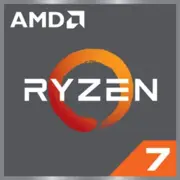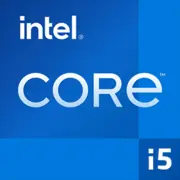AMD Ryzen 7 5700X vs Intel Core i5-13400F
CPU-Vergleichsergebnis
Nachfolgend finden Sie die Ergebnisse eines Vergleichs von
AMD Ryzen 7 5700X
und
Intel Core i5-13400F
Prozessoren basierend auf wichtigen Leistungsmerkmalen sowie Stromverbrauch und vielem mehr.
Vorteile
- Größer L3-Cache: 32MB (32MB vs 20 MB)
- Mehr Gesamtzahl der Kerne: 10 (8 vs 10)
- Neuer PCI-Express-Version: 5.0 and 4.0 (PCIe 4.0 vs 5.0 and 4.0)
- Höher Speichertypen: Up to DDR5 4800 MT/s Up to DDR4 3200 MT/s (DDR4 vs Up to DDR5 4800 MT/s Up to DDR4 3200 MT/s)
- Neuer Erscheinungsdatum: January 2023 (April 2022 vs January 2023)
Basic
AMD
Markenname
Intel
April 2022
Erscheinungsdatum
January 2023
Desktop
Plattform
Desktop
-
Modellname
?
Die Anzahl der Intel-Prozessoren ist neben der Prozessormarke, den Systemkonfigurationen und Benchmarks auf Systemebene nur einer von mehreren Faktoren, die bei der Auswahl des richtigen Prozessors für Ihre Computeranforderungen berücksichtigt werden müssen.
i5-13400F
Vermeer
Kernarchitektur
Raptor Lake
CPU-Spezifikationen
8
Gesamtzahl der Kerne
?
Kerne ist ein Hardwarebegriff, der die Anzahl unabhängiger Zentraleinheiten in einer einzelnen Computerkomponente (Chip oder Chip) beschreibt.
10
16
Gesamtzahl der Threads
?
Wo zutreffend, ist die Intel® Hyper-Threading-Technologie nur auf Performance-Kernen verfügbar.
16
-
Performance-Kerne
6
-
Energieeffiziente Kerne
4
3.4GHz
Grundfrequenz
-
Up to 4.6GHz
Maximale Turbofrequenz
?
Die maximale Turbofrequenz ist die maximale Single-Core-Frequenz, mit der der Prozessor mit Intel® Turbo Boost-Technologie und, falls vorhanden, Intel® Turbo Boost Max Technology 3.0 und Intel® Thermal Velocity Boost arbeiten kann. Die Frequenz wird typischerweise in Gigahertz (GHz) oder Milliarden Zyklen pro Sekunde gemessen.
4.60 GHz
-
Intel Turbo Boost Max Technology 3.0
?
Intel® Turbo Boost Max Technology 3.0 identifies the best performing core(s) on a processor and provides increased performance on those cores through increasing frequency as needed by taking advantage of power and thermal headroom.
No
-
Intel Hyper-Threading Technology
?
Intel® Hyper-Threading Technology (Intel® HT Technology) delivers two processing threads per physical core. Highly threaded applications can get more work done in parallel, completing tasks sooner.
Yes
-
Intel Turbo Boost Technology
?
Intel® Turbo Boost Technology dynamically increases the processor's frequency as needed by taking advantage of thermal and power headroom to give you a burst of speed when you need it, and increased energy efficiency when you don’t.
2.0
512KB
L1-Cache
-
4MB
L2-Cache
-
32MB
L3-Cache
20 MB
AM4
Sockel
?
Der Sockel ist die Komponente, die die mechanischen und elektrischen Verbindungen zwischen Prozessor und Motherboard herstellt.
FCLGA1700
Yes
Unlocked for Overclocking
?
AMD`s product warranty does not cover damages caused by overclocking, even when overclocking is enabled via AMD hardware and/or software. GD-26.
-
TSMC 7nm FinFET
Herstellungsprozess
?
Lithographie bezieht sich auf die Halbleitertechnologie, die zur Herstellung eines integrierten Schaltkreises verwendet wird, und wird in Nanometern (nm) angegeben, was die Größe der auf dem Halbleiter aufgebauten Strukturen angibt.
Intel 7
65W
Thermal Design Power (TDP)
65 W
-
Prozessor-Basisleistung
?
Die zeitlich gemittelte Verlustleistung, die der Prozessor nachweislich während der Herstellung nicht überschreitet, während er eine von Intel spezifizierte Arbeitslast mit hoher Komplexität bei der Basisfrequenz und der Sperrschichttemperatur ausführt, wie im Datenblatt für das SKU-Segment und die Konfiguration angegeben.
65 W
-
Maximale Turbo-Power
?
Die maximale anhaltende (>1 s) Verlustleistung des Prozessors, begrenzt durch Strom- und/oder Temperaturkontrollen. Die Momentanleistung kann für kurze Zeit (<=10 ms) die maximale Turboleistung überschreiten. Hinweis: Die maximale Turboleistung ist vom Systemanbieter konfigurierbar und kann systemspezifisch sein.
148 W
90°C
Maximale Betriebstemperatur
?
Die Sperrschichttemperatur ist die maximal zulässige Temperatur am Prozessorchip.
100°C
PCIe 4.0
PCI-Express-Version
?
PCI Express Revision ist die unterstützte Version des PCI Express-Standards. Peripheral Component Interconnect Express (oder PCIe) ist ein Hochgeschwindigkeitsstandard für serielle Computererweiterungsbusse zum Anschließen von Hardwaregeräten an einen Computer. Die verschiedenen PCI-Express-Versionen unterstützen unterschiedliche Datenraten.
5.0 and 4.0
-
Anzahl der PCI-Express-Lanes
?
Eine PCI Express (PCIe)-Lane besteht aus zwei differenziellen Signalpaaren, eines zum Empfangen von Daten, eines zum Senden von Daten, und ist die Grundeinheit des PCIe-Busses. Max. Anzahl der PCI Express-Lanes ist die Gesamtzahl der unterstützten Lanes.
20
-
Befehlssatz
?
Der Befehlssatz ist ein hartes Programm, das im CPU gespeichert ist und die CPU-Operationen leitet und optimiert. Mit diesen Befehlssätzen kann die CPU effizienter arbeiten. Es gibt viele Hersteller, die CPUs entwerfen, was zu verschiedenen Befehlssätzen führt, wie dem 8086-Befehlssatz für das Intel-Lager und dem RISC-Befehlssatz für das ARM-Lager. x86, ARM v8 und MIPS sind alle Codes für Befehlssätze. Befehlssätze können erweitert werden; zum Beispiel fügte x86 64-Bit-Unterstützung hinzu, um x86-64 zu erstellen. Hersteller, die CPUs entwickeln, die mit einem bestimmten Befehlssatz kompatibel sind, benötigen die Genehmigung des Befehlssatz-Patentinhabers. Ein typisches Beispiel ist Intel, das AMD autorisiert, um CPUs zu entwickeln, die mit dem x86-Befehlssatz kompatibel sind.
64-bit
-
Intel 64
?
Intel® 64 architecture delivers 64-bit computing on server, workstation, desktop and mobile platforms when combined with supporting software.¹ Intel 64 architecture improves performance by allowing systems to address more than 4 GB of both virtual and physical memory.
Yes
-
PCI Express Configurations
?
PCI Express (PCIe) Configurations describe the available PCIe lane configurations that can be used to link to PCIe devices.
Up to 1x16+4 | 2x8+4
Speicherspezifikationen
DDR4
Speichertypen
?
Intel®-Prozessoren gibt es in vier verschiedenen Typen: Single Channel, Dual Channel, Triple Channel und Flex Mode. Die maximal unterstützte Speichergeschwindigkeit kann niedriger sein, wenn bei Produkten, die mehrere Speicherkanäle unterstützen, mehrere DIMMs pro Kanal bestückt werden.
Up to DDR5 4800 MT/s Up to DDR4 3200 MT/s
-
Maximale Speichergröße
?
Die maximale Speichergröße bezieht sich auf die maximale vom Prozessor unterstützte Speicherkapazität.
192 GB
2
Maximale Anzahl an Speicherkanälen
?
Die Anzahl der Speicherkanäle bezieht sich auf den Bandbreitenbetrieb für reale Anwendungen.
2
Up to 3200MT/s
Busgeschwindigkeit
-
-
Maximale Speicherbandbreite
?
Max Memory bandwidth is the maximum rate at which data can be read from or stored into a semiconductor memory by the processor (in GB/s).
76.8 GB/s
GPU-Spezifikationen
Discrete Graphics Card Required
Integrierte GPU
?
Eine integrierte GPU bezieht sich auf den Grafikkern, der in den CPU-Prozessor integriert ist. Durch die Nutzung der leistungsstarken Rechenfähigkeiten und intelligenten Energieeffizienzverwaltung des Prozessors bietet sie eine hervorragende Grafikleistung und ein flüssiges Anwendungserlebnis bei geringerem Stromverbrauch.
-
Verschiedenes
-
Intel Virtualization Technology for Directed I/O (VT-d)
?
Intel® Virtualization Technology for Directed I/O (VT-d) continues from the existing support for IA-32 (VT-x) and Itanium® processor (VT-i) virtualization adding new support for I/O-device virtualization. Intel VT-d can help end users improve security and reliability of the systems and also improve performance of I/O devices in virtualized environments.
Yes
-
Intel Virtualization Technology (VT-x)
?
Intel® Virtualization Technology (VT-x) allows one hardware platform to function as multiple “virtual” platforms. It offers improved manageability by limiting downtime and maintaining productivity by isolating computing activities into separate partitions.
Yes
-
Intel Standard Manageability (ISM)
?
Intel® Standard Manageability is the manageability solution for Intel vPro® Essentials platforms and is a subset of Intel® AMT with out-of-band management over Ethernet and Wi-Fi, but no KVM or new life cycle management features.
Intel® SSE4.1 | Intel® SSE4.2 | Intel® AVX2
-
Enhanced Intel SpeedStep Technology
?
Enhanced Intel SpeedStep® Technology is an advanced means of enabling high performance while meeting the power-conservation needs of mobile systems. Conventional Intel SpeedStep® Technology switches both voltage and frequency in tandem between high and low levels in response to processor load. Enhanced Intel SpeedStep® Technology builds upon that architecture using design strategies such as Separation between Voltage and Frequency Changes, and Clock Partitioning and Recovery.
Yes
-
Execute Disable Bit
?
Execute Disable Bit is a hardware-based security feature that can reduce exposure to viruses and malicious-code attacks and prevent harmful software from executing and propagating on the server or network.
Yes
-
Cache
?
CPU Cache is an area of fast memory located on the processor. Intel® Smart Cache refers to the architecture that allows all cores to dynamically share access to the last level cache.
20 MB Intel® Smart Cache
-
Intel AES New Instructions
?
Intel® AES New Instructions (Intel® AES-NI) are a set of instructions that enable fast and secure data encryption and decryption. AES-NI are valuable for a wide range of cryptographic applications, for example: applications that perform bulk encryption/decryption, authentication, random number generation, and authenticated encryption.
Yes
-
Intel Volume Management Device (VMD)
?
Intel® Volume Management Device (VMD) provides a common, robust method of hot plug and LED management for NVMe-based solid state drives.
Yes
-
Intel Boot Guard
?
Intel® Device Protection Technology with Boot Guard helps protect the system’s pre-OS environment from viruses and malicious software attacks.
Yes
-
Intel VT-x with Extended Page Tables (EPT)
?
Intel® VT-x with Extended Page Tables (EPT), also known as Second Level Address Translation (SLAT), provides acceleration for memory intensive virtualized applications. Extended Page Tables in Intel® Virtualization Technology platforms reduces the memory and power overhead costs and increases battery life through hardware optimization of page table management.
Yes
-
Intel Control-Flow Enforcement Technology
?
CET - Intel Control-flow Enforcement Technology (CET) helps protect against the misuse of legitimate code snippets through return-oriented programming (ROP) control-flow hijacking attacks.
Yes
-
Intel Deep Learning Boost (Intel DL Boost)
Yes
-
Intel OS Guard
Yes
Windows 11 - 64-Bit Edition, Windows 10 - 64-Bit Edition, RHEL x86 64-Bit, Ubuntu x86 64-Bit *Operating System (OS) support will vary by manufacturer.
OS Support
-
Benchmarks
Geekbench 6 Einzelkern
Ryzen 7 5700X
2116
Core i5-13400F
2288
+8%
Geekbench 6 Mehrkern
Ryzen 7 5700X
9715
Core i5-13400F
10676
+10%
Geekbench 5 Einzelkern
Ryzen 7 5700X
1630
Core i5-13400F
1664
+2%
Geekbench 5 Mehrkern
Ryzen 7 5700X
8713
Core i5-13400F
10633
+22%
Passmark CPU Einzelkern
Ryzen 7 5700X
3384
Core i5-13400F
3661
+8%
Passmark CPU Mehrkern
Ryzen 7 5700X
26705
+6%
Core i5-13400F
25268






